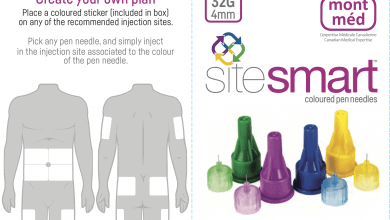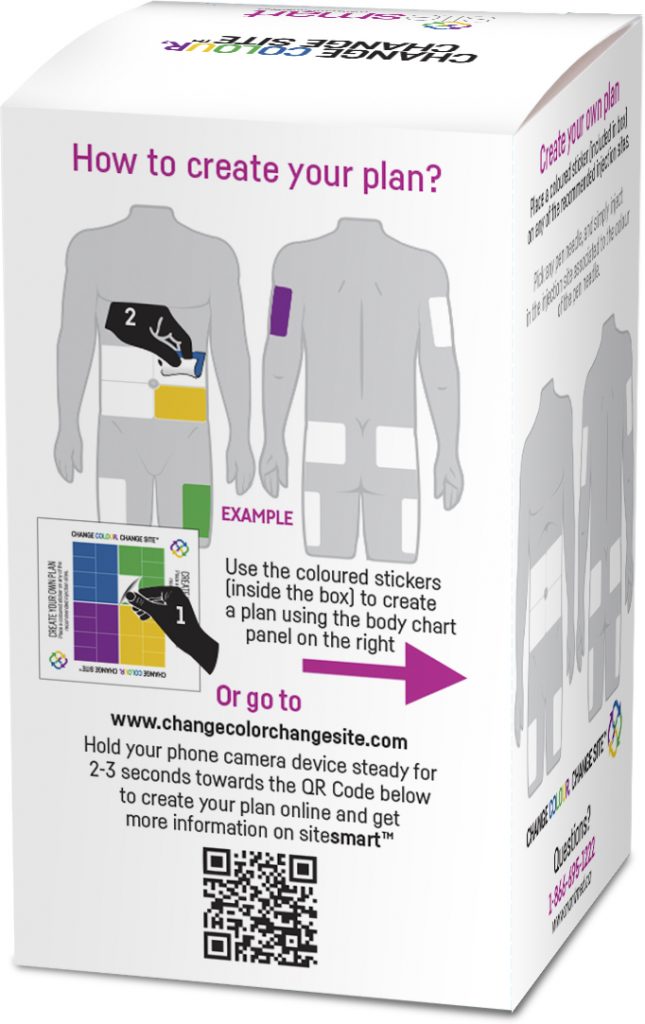Easy, Affordable Tool to Improve Site Rotation
A new product out of Canada helps you remember to rotate your insulin injection sites with simple, color-coded pen needles


We spoke with Amir Farzam, CEO of MontMed (website) about SiteSmart, a new color-based site rotation system for insulin pen users. Read his impressive bio at the end of the article.
If you have type 1 diabetes are using insulin pens to control your blood sugar, you are probably vaguely aware that you should be rotating your injection sites. But what exactly does that mean? And, more importantly, how are you supposed to remember where to inject when you have so many other things to keep track of?
If you are like most T1Ds, you may not know exactly what site rotation entails or how to do it correctly. And even if you do know, you probably don’t do it as often as you should simply because it’s hard to keep track of day after day.
With so much to think about when managing your diabetes, ignoring this one little concept may not seem like a big deal. But failing to change up your injection sites is likely having a huge impact on your overall BG control. Luckily, MontMed, a company out of Canada, has come up with a simple system called SiteSmart that makes site rotation easy to do without adding any extra steps to your routine.
Failure to Rotate Sites May Make Blood Sugars More Unpredictable
You are not alone if you have never been told to rotate your injection sites. Newly diagnosed people with diabetes get so much information at once, that this little tidbit often fails to stick. Worse still, many doctors aren’t aware of the importance of site rotation or how to effectively teach the practice.
For those who are new to the concept, site rotation simply entails switching between viable injection sites–such as your upper arms, buttocks, and stomach, as well as using as most real estate as possible within that zone–each time you take your insulin. If you use one location too frequently, the constant trauma to the skin and underlying tissues by the needle and injected insulin can cause excess fat tissue to form.
This common complication is known as lipohypertrophy and it is estimated that as many as 65% of insulin users suffer from lipohypertrophy. If you are one of them, your diabetes management is likely suffering.
Lipohypertrophy is a lump under the skin caused by the accumulation of extra fat at the site of many subcutaneous injections of insulin. (Wikipedia)
![]() Not only can this fatty scar tissue cause pain and inflammation, but it can actually affect how well insulin is absorbed. In fact, studies have shown that it can result in 37% lower insulin exposure and 58% higher mean blood sugar after injection. To make matters worse, if you are like most people, you will have a mix of lipo tissue and normal tissue. This can result in widely variable BG outcomes from the same insulin dose depending on where you inject.
Not only can this fatty scar tissue cause pain and inflammation, but it can actually affect how well insulin is absorbed. In fact, studies have shown that it can result in 37% lower insulin exposure and 58% higher mean blood sugar after injection. To make matters worse, if you are like most people, you will have a mix of lipo tissue and normal tissue. This can result in widely variable BG outcomes from the same insulin dose depending on where you inject.
Not surprisingly, all this poorly absorbed insulin and variation in blood sugar outcomes can have a significant effect on your A1C. Multiple studies have found a link between a lack of proper site rotation and an increased risk of lipohypertrophy. In fact, lack of proper site rotation has been shown to be the most important risk factor in causing lipohypertrophy, which in turn, has an important impact on glycemic control.
![]() A Global study on injection techniques with 13,289 insulin users has shown that people who were rotating their site properly had almost .6% lower A1C on average compared to those who don’t. They also had less lipohypertrophy, less glucose variability, less unexplained hypoglycemia and were using less insulin.
A Global study on injection techniques with 13,289 insulin users has shown that people who were rotating their site properly had almost .6% lower A1C on average compared to those who don’t. They also had less lipohypertrophy, less glucose variability, less unexplained hypoglycemia and were using less insulin.
But don’t worry if you’re one of the majority of T1D patients who don’t rotate, as it’s never too late to learn. In fact, people with diabetes who received training on injection techniques, including site rotation, saw an A1C drop between 0.5% and 1.0%, depending on their degree of lipohypertrophy, after just six months of proper site rotation and injection techniques.
Even better still, MontMed’s new product, SiteSmart, is here to do all the hard work for you.
SiteSmart Is a No Brainer for Pen Users
Knowing that you should rotate your sites is one thing. Actually remembering to do it properly and constantly, is another. SiteSmart helps you remember to rotate your sites without adding any additional steps to your already complex management schedule.
So how does it work?
By incorporating colors to transform pen needles into a tool that helps insulin users achieve better injection site rotation.
Sitemart consists of a box of 100 pen needles in 4 distinctive colors of 25 needles each.

Each box includes a body diagram with typical injection sites outlined, and a pad of colored stickers, which forms an association tool. The first step is simply to create your own injection site rotation plan by assigning each color of pen needles to each injection site.
Then, each time you pick up a pen needle to inject, simply inject in the site associated with the color of the pen needle on your plan. And that’s it! No need to track, no need to think about where to inject, no need to remember where you injected last… This simple technique assures that you switch sites based on the color of pen needle you pull from the box. ‘
You can also access a web app version of the body map association tool on your phone, through a QR code directly on the packaging.
Since most T1Ds inject insulin multiple times each day, it shouldn’t be long before you remember which color is associated with each injection site.

Once you have the color associations committed to memory, all the hard work is done. The mixed assortment of colored pen needles in each box and the probability of picking any one color will guarantee you rotate your sites frequently throughout the week.
Insulin Users in the US Will Have to Wait
The only downside to this super-simple product is that it is not yet available in the US. If you live in Canada, you do have the option to choose the SiteSmart pen needles in place of traditional pen needles.
Montmed, the company behind the SiteSmart concept, is in early discussions with several potential partners. We hope they succeed in finding a commercial partner who is committed to improving diabetes care by integrating this product into their portfolio of pen needles so that insulin users in the US can also benefit from this innovation. Not only would manufacturing colored pen needles be easy and cost-effective for a company that already sells similar products, but the value to consumers and payers would be huge.
Current studies indicate this product is so simple to use that most insulin users improve site rotation and improve outcomes, making it a no brainer for insurance companies to cover.
Such a simple, easy-to-use, and effective product may seem too good to be true. Unfortunately, if you live in the US right now, it is. But, with such promising results from initial trials and a potential to corner the pen needle market though clinical value, we are hopeful this product will be picked up by an American company and become available in the states very soon.
Background of Amir Farzam
Amir has worked for 13 years as an entrepreneur and CEO in diabetes medical device commercialization as well as not-for-profit diabetes education. His expertise is developing company strategy while leading all operational tactics and building business models anchored in innovation.
Prior to Montmed, Amir co-founded and led Farir Teb, an Iran-based medical device company, which became the market leader of diabetes devices in Iran over a period of 5 years.
Amir also co-founded and sat on the board of directors of Gabric Diabetes Education Association, which became the best practice of diabetes education in MENA (Middle-East and North Africa), a member of IDF (International Diabetes Federation) and recognized by WHO (World Health Organization).